
The Rocky Mountains, also known as the Rockies, are a major mountain range and the largest mountain system in North America. The Rocky Mountains stretch 3,000 miles in straight-line distance from the northernmost part of western Canada, to New Mexico in the southwestern United States. Depending on differing definitions between Canada and the U.S., its northern terminus is located either in northern British Columbia's Terminal Range south of the Liard River and east of the Trench, or in the northeastern foothills of the Brooks Range/British Mountains that face the Beaufort Sea coasts between the Canning River and the Firth River across the Alaska-Yukon border. Its southernmost point is near the Albuquerque area adjacent to the Rio Grande rift and north of the Sandia–Manzano Mountain Range. Being the easternmost portion of the North American Cordillera, the Rockies are distinct from the tectonically younger Cascade Range and Sierra Nevada, which both lie farther to its west.

The Mountain Time Zone of North America keeps time by subtracting seven hours from Coordinated Universal Time (UTC) when standard time (UTC−07:00) is in effect, and by subtracting six hours during daylight saving time (UTC−06:00). The clock time in this zone is based on the mean solar time at the 105th meridian west of the Greenwich Observatory. In the United States, the exact specification for the location of time zones and the dividing lines between zones is set forth in the Code of Federal Regulations at 49 CFR 71.
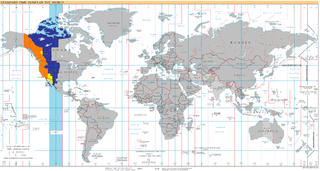
UTC−07:00 is an identifier for a time offset from UTC of −07:00. In North America, it is observed in the Mountain Time Zone during standard time, and in the Pacific Time Zone during the other eight months. Some locations use it year-round.

Alypia ridingsii, the mountain forester or Ridings' forester, is a moth of the family Noctuidae. The species was first described by Augustus Radcliffe Grote in 1864. It is found in North America as far east as the eastern edge of the Rocky Mountains in Colorado. It is also found in Arizona, Utah, all of California and northward into Oregon, Idaho, Washington, British Columbia and Alaska
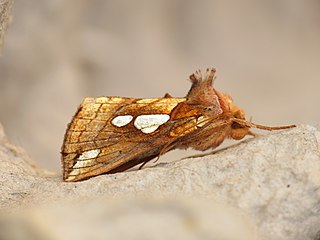
Plusia putnami, the Lempke's gold spot or Putnam's looper moth, is a species of moth of the family Noctuidae. It is found in the Palearctic realm, from Japan and eastern Siberia to Fennoscandia, Great Britain, and France. In North America, it ranges from Newfoundland and Labrador to central Alaska and the interior of British Columbia, south to Pennsylvania, Washington, north-eastern California, and in the Rocky Mountains to Utah and Colorado.

Raphia frater, the brother moth or simply the brother, is a moth of the family Noctuidae. It is found from Nova Scotia west, across the forested regions of Canada to British Columbia, south to Mississippi in the east. The southern limits in the west are uncertain due to confusion with several closely related species or forms.
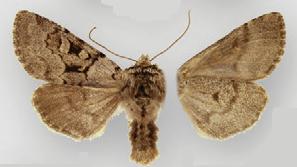
Lasionycta conjugata is a moth of the family Noctuidae. It is found in the Rocky Mountains from central Utah and Colorado north to the Beartooth Plateau on the Montana-Wyoming border.

Lasionycta fergusoni is a moth of the family Noctuidae. It is found from the southern Washington Cascades through British Columbia and Alberta to southern Yukon.
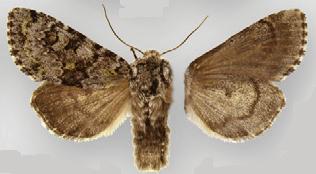
Lasionycta mutilata is a moth of the family Noctuidae. It is found from Oregon and Yellowstone National Park, Montana and Wyoming, northward to the Alaskan Panhandle and the Rocky Mountains of Alberta. It is absent from the Queen Charlotte Islands.

Lasionycta poca is a moth of the family Noctuidae first described by William Barnes and Foster Hendrickson Benjamin in 1923. It is found throughout the Rocky Mountains of Alberta, westward to the Coast Range in western British Columbia and southward in the Cascades to Okanogan County, Washington.

Lasionycta sasquatch is a moth of the family Noctuidae. It is found in the Washington Cascades south of Snoqualmie Pass, Saddle Mountain in the Oregon Coast Range, and the Siskiyou Mountains in south-western Oregon.

Lasionycta perplexa is a moth of the family Noctuidae. It is widely distributed from southern Alaska and Yukon in the north to California, Utah, and Colorado in the South. A disjunct population is found on the east coast of Hudson Bay at Kuujjuaraapik.

Lasionycta quadrilunata is a moth of the family Noctuidae. It is found from south-central Alaska down the spine of the Rocky Mountains to Colorado.

Lasionycta lagganata is a moth of the family Noctuidae first described by William Barnes and Foster Hendrickson Benjamin in 1924. It is only known from three localities in south-western Canada: Banff and Waterton national parks in Alberta and the Purcell Mountains in south-eastern British Columbia.

Lasionycta uniformis is a moth of the family Noctuidae. It is widely distributed in the mountains of western North America. It occurs from southern Yukon to northern California and Colorado, with an isolated population in eastern Quebec.

Lasionycta brunnea is a moth of the family Noctuidae. It occurs in the Rocky Mountains of Alberta north to Pink Mountain in north-eastern British Columbia, and in the Purcell and Selkirk Mountains in south-western British Columbia and north-eastern Washington.
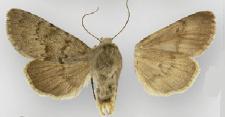
Lasionycta promulsa is a moth of the family Noctuidae. It occurs from Rampart House in northern Yukon to south-western British Columbia in the west and southern New Mexico in the Rocky Mountains.
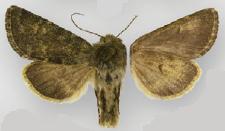
Lasionycta silacea is a moth of the family Noctuidae. It occurs from the British Columbia Coast Range and the Washington Cascades to extreme south-western Alberta.

Lasionycta impingens is a moth of the family Noctuidae. It occurs from southern Yukon to Colorado.

There are 14 species of amphibians and 5 species of reptiles known to occur in Mount Rainier National Park.










